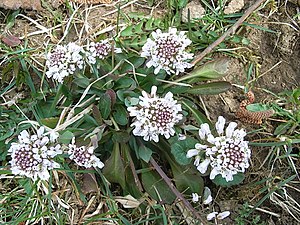Mountain Hellerkraut
| Mountain Hellerkraut | ||||||||||||
|---|---|---|---|---|---|---|---|---|---|---|---|---|

Mountain bagwort ( Noccaea caerulescens ) |
||||||||||||
| Systematics | ||||||||||||
|
||||||||||||
| Scientific name | ||||||||||||
| Noccaea caerulescens | ||||||||||||
| ( J.Presl & C.Presl ) FKMey. |
The mountain hellerkraut , mountain pocket herb , alpine hellerkraut or pre-alpine hellerkraut ( Noccaea caerulescens ) is a species of the cruciferous family (Brassicaceae).
description
The mountain light herb grows as a perennial herbaceous plant and reaches a height of 5 to 25 cm. It has non-flowering rosettes, but unlike the similar Berg-Hellerkraut, it has no stolon-like, elongated shoots. The leaves are blue-green, glabrous and greasy. The white to blue-violet flowers are in elongated, racemose inflorescences.
The flowering period is March to May.
The number of chromosomes is 2n = 14.
Occurrence
The Gebirgs-Hellerkraut is widespread pre-alpine in the southern, central and eastern European mountains. The plant grows gregariously in mountain meadows or on grassy embankments from March to May. It prefers low-lime, moderately acidic, humus clay soils. Because of its frequent self-pollination, which often preserves newly acquired traits in small isolated occurrences, the mountain Hellerkraut is rich in forms.
ingredients
This European plant species is able to take up zinc and store it in the tissue. The concentration of zinc in the plant parts can be up to 300 times compared to what most plants have as a tolerance limit.
Systematics
It is therefore also seen as a collection of several small species. Synonyms for Noccaea caerulescens (J.Presl & C.Presl) FKMey. are Thlaspi caerulescens J.Presl & C.Presl and Thlaspi alpestre (L.) L. non Jacq. .
Central European subspecies
- Noccaea caerulescens subsp. brachypetala (Jord.) Tzvelev usually has a knotty stem, and the anthers remain yellow or reddish. The bracts are 2 to 3 mm long and are a little longer than the calyx. It grows in Austria, for example often in the Montafon . It occurs in societies of the Polygono-Trisetion association.
- Noccaea caerulescens subsp. caerulescens usually has a simple stem, the anthers turn blue-violet. The bracts are up to 3, 5 mm long and are twice as long as the calyx. The plant is two to three years old, the petals are as long or shorter than the stamens. It is a plant of mountain meadows, more rarely valley meadows in the Alpine foothills , Black Forest , Rhenish Slate Mountains , in Thuringia , Saxony , the Fichtel Mountains and the Bavarian Forest . It thrives in societies of the Polygono-Trisetion association, but also occurs in those of the Arrhenatherion association.
- Noccaea caerulescens subsp. calaminaris (Lej.) Mag. , the calamine plant , is persistent and the bracts are longer than the stamens. The subspecies, which is also regarded as a species, occurs in patchy heavy metal lawns , for example near Aachen and Osnabrück . It is a character species of the association Thlaspion calaminariae.
literature
- Erich Oberdorfer : Plant-sociological excursion flora for Germany and neighboring areas, Ulmer, Stuttgart 2001, ISBN 978-3-8001-3131-0 .
Individual evidence
- ↑ a b Eckehart J. Jäger (ed.): Rothmaler, Exkursionsflora von Deutschland, vascular plants: basic volume . 20th edition - Spectrum, Heidelberg, 2011, ISBN 978-3-8274-1606-3 , p. 549
- ↑ a b c d e Erich Oberdorfer : Plant-sociological excursion flora for Germany and neighboring areas . With the collaboration of Angelika Schwabe and Theo Müller. 8th, heavily revised and expanded edition. Eugen Ulmer, Stuttgart (Hohenheim) 2001, ISBN 3-8001-3131-5 , pp. 448-449 .
Web links
- Taxonomy according to www.planto.de
- Mountain Hellerkraut. In: FloraWeb.de.
- Distribution map for Germany. In: Floraweb .
- Thlaspi caerulescens J. & C. Presl In: Info Flora , the national data and information center for Swiss flora . Retrieved October 26, 2015.
- Thlaspi alpestre aggr. In: Info Flora , the national data and information center for Swiss flora . Retrieved October 26, 2015.
- Thomas Meyer: Data sheet with identification key and photos at Flora-de: Flora von Deutschland (old name of the website: Flowers in Swabia )